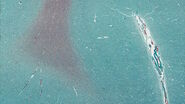Preparation Conditions: Mechanical Pre-Preparation
Grinding the cross section to achieve a flat surface and a 90° angle between surface and cross sectional surface.
Ion milling
| Sample holder: | 45°-sloped cutting holder |
| Acceleration voltage: | 7 kV |
| Milling time: | 180 - 220 min |
| Sample movement: | Oscillation (60°) |
Results
Using ion beam slope cutting, clean cuts through the complete structure of the membrane filter were successfully produced. The layer structure with the different pore sizes is clearly recognizable. The pore structure was not distorted due to the ion beam incidence, being parallel to the slope. Even pores of a few nanometres can be resolved in the scanning electron microscope.








